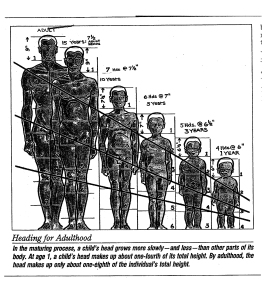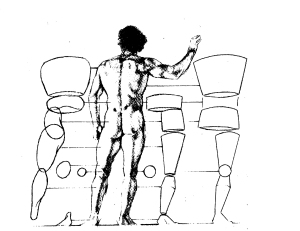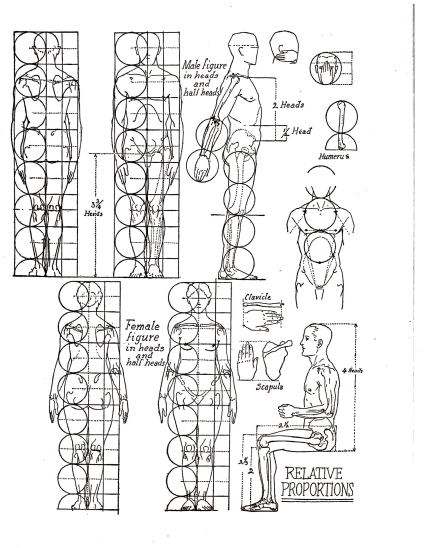Category Archives: DRAWING HUMANS
DRAWING THE HUMAN FIGURE
It’s been a while since I blogged — had a lot going on in my life lately. Today, I’m merely passing along some information about drawing the human form that I’ve gleaned from books and magazines. Unfortunately, I have no idea WHAT books and magazines I got these from. Suffice it to say that my students learned a lot from these charts. The first one is about the growth of children. You can see from this why babys’ heads and eyes always seem to be so big– they don’t grow as fast as the other parts of the body. I apologize for the darkness of the example — it was on colored paper!
This next chart illustrates how the different sections of the body can be seen as basic forms: cylinders, spheres, wedges. It is much easier to draw figures if you think about various parts as simply shapes and forms.
In the future, I probably will not be posting drawing/painting lessons from my classes. Instead, I will be sharing the artwork I have finished lately, or working on at the present. I may be hanging up my apron as an art teacher! At least for the summer! Happy drawing to all of you!
BASIC PROPORTIONS OF THE HUMAN BODY
The ancient Greeks studied real human proportions in order to make their statues more ideal. The Roman architect, Vitruvius in the 1st century BC also studied the relationships of the human body and used these in his buildings. Leonardo DaVinci is known for his “Vitruvian Man” which he got from Vitruvius’ writings. He used the human head as his comparison point and based his measurements on an ideal proportion of 8 heads tall. This is pretty convenient in that the figure is 4 heads tall at the lower part of the torso, and can be divided into quarter points at the chest and knees. The arms are usually divided into half at the elbow as will the legs just below the knee.
But the human body is different in everyone. Most artists now say that the figure is 7 ½ heads tall, as in the following example. This was developed by a 19th century anatomist, Dr. Paul Richer. The half-way mark is just a little below the pubic bone, and the third head is at the belly button.
In the example below, see that the human body is basically 7 ½ heads or 7 heads tall, based on the length of the head. Males and females are the same, which means, of course, that the female head is smaller than the male. See where the arms come to – the waist, the knee, the pelvic bones. This is only a guide, because you have to look closely at your model to see his/her true proportions.
The illustration below is taken from Anatomy and Drawing by Victor Perard, 13th printing 1948 – one of my most prized drawing books.
If you really want to learn how to draw the human body, draw from photos, magazine pictures, and any time you’re sitting in a waiting room with others. Keep your sketchbook and pencil handy. One caveat, however: If you draw from fashion models, realize that the rule of 7 1/2 heads does not apply. Fashion illustrators and photographers enlongate the female figure so as to make the clothes look better. CHECK IT OUT!


